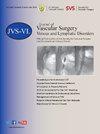急性孤立性小腿肌肉静脉血栓形成患者血栓传播的发生率、预测因素和临床结果。
IF 2.8
2区 医学
Q2 PERIPHERAL VASCULAR DISEASE
Journal of vascular surgery. Venous and lymphatic disorders
Pub Date : 2025-05-10
DOI:10.1016/j.jvsv.2025.102259
引用次数: 0
摘要
目的:本研究的目的是评估孤立性小腿肌肉静脉血栓形成(CMVT)患者血栓传播的发生率、预测因素和临床结果。方法:本回顾性观察研究纳入了2022年1月1日至2024年8月1日期间诊断为孤立性CMVT的所有连续住院患者。收集了人口统计学、合并症、实验室生物标志物和管理策略的数据。主要终点是随访期间血栓扩散的发生率(定义为先前在小腿肌肉静脉内发现的延伸到小腿静脉轴或同侧肢体近端静脉的血栓,或血栓明显延伸但仍局限于小腿肌肉静脉)。次要终点包括静脉血栓栓塞(VTE)复发的发生率(定义为在原始CMVT完全消退后随访期间影像学证实的新血栓形成[同侧或对侧深静脉血栓形成或肺栓塞])、出血事件、再住院和死亡。结果:本研究纳入的459例患者中,CMVT传播发生率为8.7% (n = 40)。血栓扩散的独立预测因子为固定不动(OR = 3.06[1.04-8.99], P = 0.042)、静脉血栓栓塞史(OR = 4.31[1.42-13.05], P = 0.010)和d -二聚体水平升高(OR = 1.06[1.02-1.09], P = 0.003)。平均繁殖时间为9.3±5.2 d。VTE增殖患者复发率为2.5% (n = 1),未增殖患者复发率为1.7% (n = 7) (P = 0.702)。有繁殖的患者有5.0% (n = 2)发生大出血,无繁殖的患者有3.1% (n = 13)发生大出血(P = 0.519)。随访期间,无患者因静脉血栓栓塞事件再次住院或死亡。结论:孤立性CMVT患者血栓扩散不常见,一般不致命。CMVT繁殖的预测因素包括固定、静脉血栓栓塞史和d -二聚体水平升高。这些发现可能有助于识别有CMVT传播风险的患者。本文章由计算机程序翻译,如有差异,请以英文原文为准。
Incidence, predictors, and clinical outcomes of thrombus propagation in patients with acute isolated calf muscle venous thrombosis
Objective
The goal of this study was to evaluate the incidence, predictors, and clinical outcomes of thrombus propagation in patients with isolated calf muscle venous thrombosis (CMVT).
Methods
This retrospective observational study included all consecutive hospitalized patients who were diagnosed with isolated CMVT between January 1, 2022, and August 1, 2024. Data on demographics, comorbidities, laboratory biomarkers, and management strategies were collected. The primary end point was the incidence of thrombus propagation (defined as either a previously localized thrombi within the muscular calf veins that was found to extend to the axis calf veins or proximal veins of the ipsilateral extremity or as a thrombus that had clearly extended but remained confined to the muscular calf veins) during follow-up. Secondary end points included the incidence of venous thromboembolism (VTE) recurrence (defined as the formation of a new thrombus [ipsilateral or contralateral deep vein thrombosis or pulmonary embolism] confirmed by imaging during follow-up after complete resolution of the original CMVT), bleeding events, rehospitalization, and death.
Results
Among the 459 patients included in this study, the incidence of CMVT propagation was 8.7% (n = 40). Independent predictors of thrombus propagation were immobilization (odds ratio [OR]; 3.06 [95% confidence interval, 1.04-8.99]; P = .042), history of VTE (OR, 4.31 [95% CI, 1.42-13.05]; P = .010), and elevated D-dimer level (OR, 1.06 [95% CI, 1.02-1.09]; P = .003). The mean time to propagation was 9.3 ± 5.2 days. VTE recurrence rates were 2.5% (n = 1) in patients with propagation and 1.7% (n = 7) in patients without propagation (P = .702). Major bleeding events occurred in 5.0% of patients (n = 2) with propagation and in 3.1% of patients (n = 13) without propagation (P = .519). During the follow-up period, no patients were rehospitalized or died owing to VTE events.
Conclusions
Thrombus propagation in patients with isolated CMVT is uncommon and generally not fatal. Predictors of CMVT propagation include immobilization, history of VTE, and elevated D-dimer level. These findings may help to identify patients with a significant risk of CMVT propagation.
求助全文
通过发布文献求助,成功后即可免费获取论文全文。
去求助
来源期刊

Journal of vascular surgery. Venous and lymphatic disorders
SURGERYPERIPHERAL VASCULAR DISEASE&n-PERIPHERAL VASCULAR DISEASE
CiteScore
6.30
自引率
18.80%
发文量
328
审稿时长
71 days
期刊介绍:
Journal of Vascular Surgery: Venous and Lymphatic Disorders is one of a series of specialist journals launched by the Journal of Vascular Surgery. It aims to be the premier international Journal of medical, endovascular and surgical management of venous and lymphatic disorders. It publishes high quality clinical, research, case reports, techniques, and practice manuscripts related to all aspects of venous and lymphatic disorders, including malformations and wound care, with an emphasis on the practicing clinician. The journal seeks to provide novel and timely information to vascular surgeons, interventionalists, phlebologists, wound care specialists, and allied health professionals who treat patients presenting with vascular and lymphatic disorders. As the official publication of The Society for Vascular Surgery and the American Venous Forum, the Journal will publish, after peer review, selected papers presented at the annual meeting of these organizations and affiliated vascular societies, as well as original articles from members and non-members.
 求助内容:
求助内容: 应助结果提醒方式:
应助结果提醒方式:


